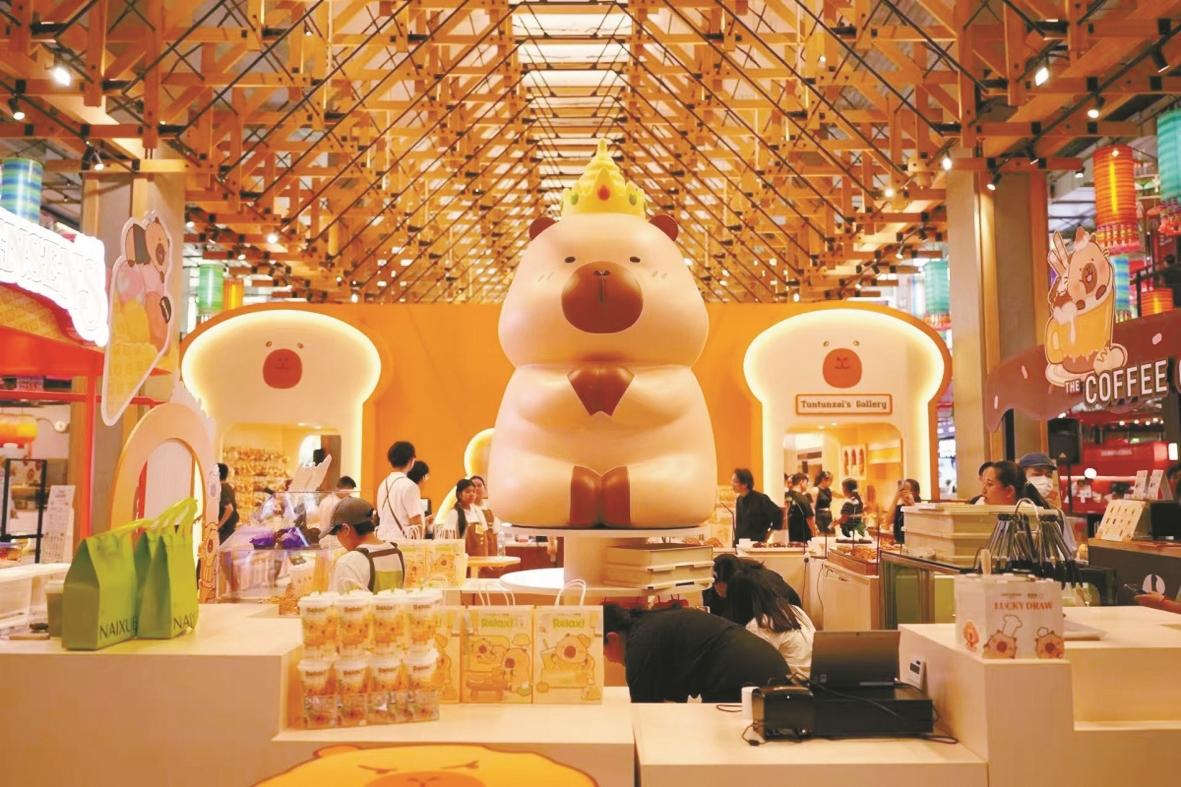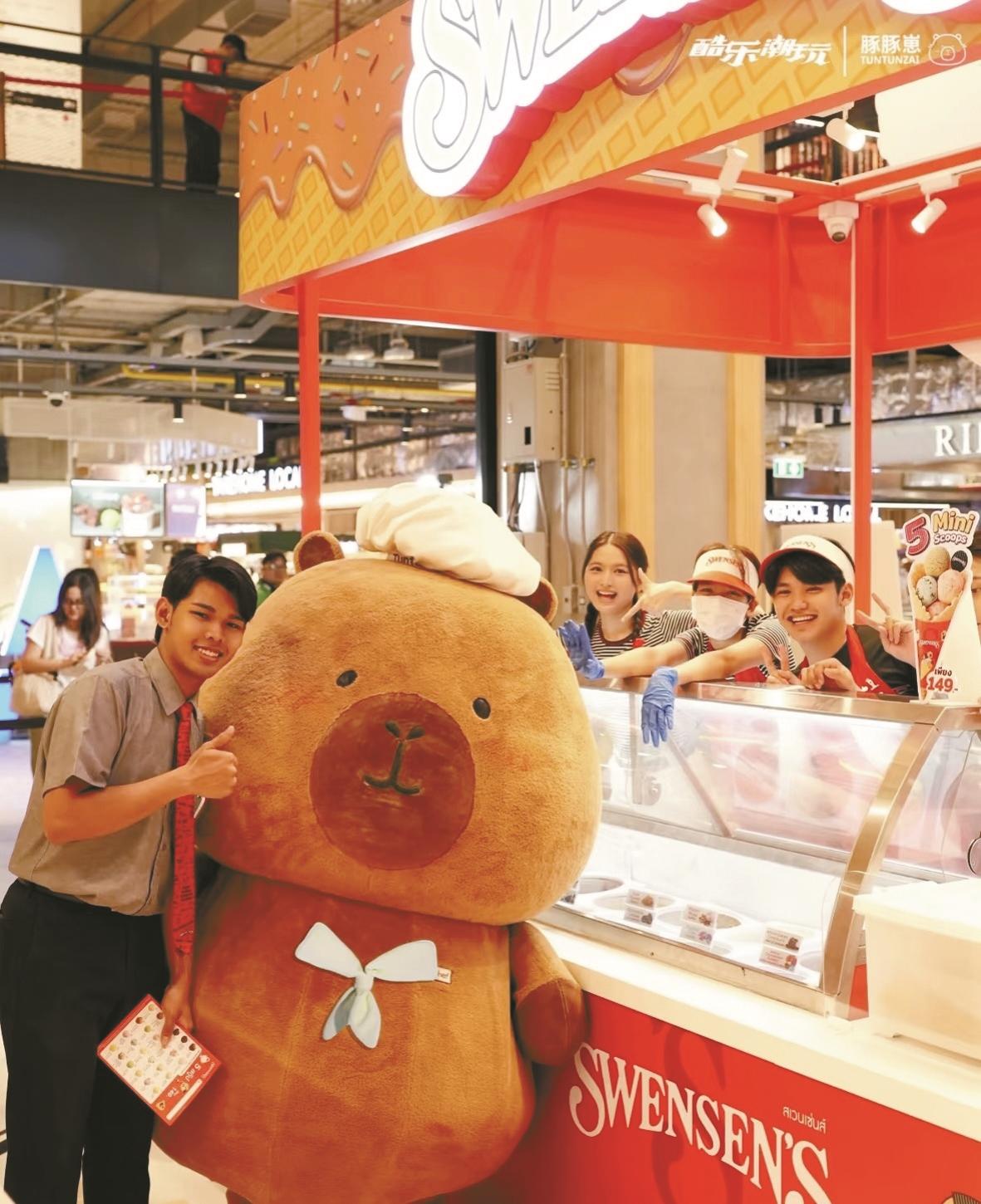In recent days, Labubu — the plush toy with a mischievous face and devilish grin — has been flying off shelves both in China and abroad, cementing its place as the darling of designer toy collectors.
Not far from the frenzy, in Ningbo, a coastal city in eastern China better known for its shipping ports than its cultural exports, a sleepy-eyed capybara with a doughy body and an aura of Zen was quietly preparing for its moment. Its name? Tuntunzai.
1
A Capybara’s Moment
Unlike Labubu’s loud presence, Tuntunzai — the original IP from Ningbo’s toy brand Kulechaowan — arrived quietly, with a slow blink that soon sparked an unexpected surge.
During this year’s May Day holiday, this soft, fluffy friend made its international debut at Bangkok’s bustling EMSPHERE mall. The 430-square-meter pop-up, themed the “Tuntunzai Baking Workshop,” combined pastel hues, the scent of fresh pastries, and lush tropical greenery to create what the creators call an immersive, healing experience for all five senses.
In just one month, the store raked in over 25 million Thai baht (about 5.5 million yuan) in sales — a breakout success that even surprised its founders.
For Wu Shengfeng, founder and CEO of Kulechaowan, this achievement represents far more than luck; it embodies over a decade of dedication and a deeper vision. “Trendy toys today aren’t just products,” Wu explained in an interview at Kulechaowan’s flagship Ningbo store. “They offer emotional connection, identity, and a way to shape—or escape—the world we live in.”
2
Hitting a Nerve — and a Market
With its doughy capybara frame, sleepy eyes, and tiny accessories like croissants and coffee mugs, Tuntunzai isn’t a hero or a troublemaker. It’s a mood — a soft, slightly indifferent presence that offers comfort in a high-pressure world.
The toy’s creation was driven by emotional insight. After years of watching trends come and go, Wu noticed a shift: people weren’t just collecting toys — they were looking for reflections of themselves.
That change in consumer mindset coincided with an online obsession in 2023 when capybaras — the world’s largest rodents — became viral icons on Chinese social media. Memes showed them soaking in hot springs, sipping bubble tea, or calmly riding bullet trains, often with captions evoking a kind of Zen detachment. “They were funny and strange,” one comment read, “but also very chill. Like the world could fall apart, and the capybara would still be blinking slowly.”
That laid-back resilience inspired Tuntunzai’s entire persona. Wu asked his design team to distill the capybara’s calm, low-key charm into an original character — something soft, emotionally grounded, and unmistakably Gen Z. The result quietly hit shelves in late 2023. By early 2024, Tuntunzai had become Kulechaowan’s top-selling original IP, accounting for nearly 10% of the company’s national sales. Children asked for it as a reward, and young adults brought it home as an emotional support figure.
Tuntunzai’s success wasn’t a stroke of luck — it was the result of years of careful observation and steady innovation by its parent company Kulechaowan.
The journey began in 2009 — not with toys, but with DVDs. Later, as the physical media market declined, founder Wu Shengfeng began searching for new opportunities. In 2012, he officially launched Kulechaowan, positioning it as one of China’s earliest players in the emerging designer toy space — nearly in step with the rise of Pop Mart. By 2018, Wu had begun forming strategic licensing partnerships with global and regional IPs, bringing in characters from Pokémon, Sanrio, Disney, Ultraman, and even cultural icons inspired by Dunhuang art.
These licensing partnerships fueled sales and boosted Kulechaowan’s visibility across China. But Wu soon recognized their limitations. Relying solely on external IPs couldn’t sustain long-term brand growth. To build a lasting competitive edge, Kulechaowan needed something more: original characters it could fully own and develop.
“Like many others in the industry, we started with a trend-driven retail model — selling figures of Ultraman, Doraemon, and Hello Kitty,” Wu said. “But the definition of ‘trendy toys’ has changed. It’s no longer about specific characters or categories — it’s about the emotional resonance they bring.”
As younger consumers increasingly seek high-quality, personalized, and experience-oriented products, Wu noticed a shift in demand: toys weren’t just for collecting or display; they were becoming sources of emotional support and personal expression.
Today, a stroll through any Kulechaowan store reveals a wide array of products that blend design, pop culture, storytelling, and IP appeal. Items tied to popular characters often draw dedicated fan bases — sometimes even bridging niche subcultures with the mainstream, a rare feat in the world of designer toys.
As Gen Z’s spending power grows, designer toy shops have flourished. Kulechaowan has expanded rapidly, now operating in over 70 cities across China.
“Kulechaowan isn’t just selling toys,” Wu said. “We’re creating a spiritual haven for urban youth — a space that reflects their desire for comfort, warmth, and a sense of belonging.”
3
A New Wave in Sight
Tuntunzai’s success reflects a broader trend in China’s creative economy — a new wave of entrepreneurs blending local craftsmanship with designs that tap into universal emotional appeal, making them ready for the global market.
Take POPOBAR (also known as POLARPOPO), another trendy toy brand from Ningbo. Founded by toy collector and “post-70s” entrepreneur Tang Xuyang, POPOBAR opened its first international store this April in Ho Chi Minh City, Vietnam.
Like Wu, Tang has also embraced the concept of “selling emotional comfort” — the idea that feelings, rather than just product functions, now drive purchases. At the store, a collection of fragrant sachets with auspicious names like “Shishi Ruyi” (May everything go as you wish) and “Good Luck Lotus” (Continuous good fortune) took center stage in the trendy toy display, filling the air with a rich herbal aroma. Known for their mosquito-repellent and sleep-calming effects, these sachets have become popular among local customers. Many buy them as “Chinese lucky charms”.
From a modest 19-square-meter shop in Ningbo to a network of over 100 stores nationwide and now its first overseas location, POPOBAR is capitalizing on the rising wave of “emotional consumption”, just like Kulechaowan, pioneering a promising new frontier in the designer toy market.
Whether the next global toy buzzword after “Labubu” will be “Tuntunzai, ”“POPOBAR,” or something else remains to be seen. One trend stands out: Made-in-China products are no longer just technology or textiles — they’re emotions brought to life through design and craftsmanship.
Rewritten by Pan Wenjie,
based on original reports by
Shi Min and Shen Tianzhou
from Yongpai.




